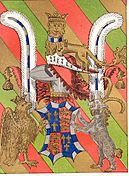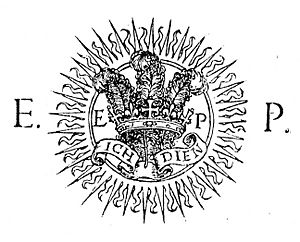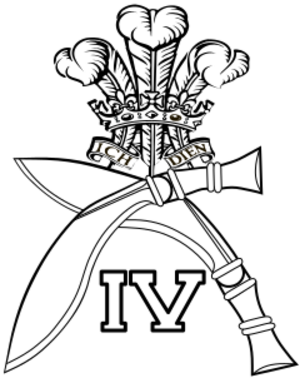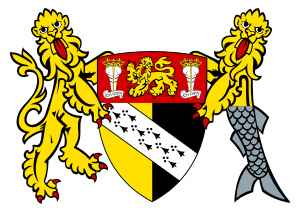Prince of Wales's feathers facts for kids
Quick facts for kids Prince of Wales's feathers |
|
|---|---|
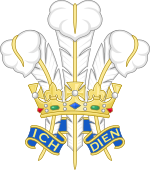 |
|
| Armiger | William, Prince of Wales |
| Blazon | A plume of three ostrich feathers argent enfiled by a royal coronet of alternate crosses and fleur-de-lys or |
| Motto | German: Ich dien (I serve) |
The Prince of Wales's feathers is a special symbol, or heraldic badge, used by the Prince of Wales. It shows three white feathers from an ostrich. These feathers are surrounded by a gold coronet (a small crown). Below the coronet, there is a ribbon with the German motto Ich dien, which means "I serve".
This badge is part of royal heraldry (the study of coats of arms and symbols). It also represents Wales, especially in Welsh rugby and some parts of the British Army.
Contents
Who Uses the Feathers?
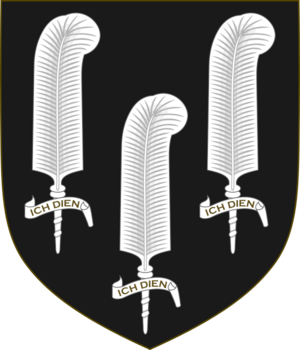
The Prince of Wales's feathers badge is not linked to the ancient Welsh princes. Instead, it is connected to the English and British Princes of Wales. This symbol is used by the heir to the throne, even if they don't yet have the title of Prince of Wales.
The Plantagenet Family and the Feathers
The story of the ostrich feathers usually starts with Edward, the Black Prince (1330–1376). He was the oldest son of King Edward III of England. The Black Prince used a shield with three white ostrich feathers on a black background. He called this his "shield for peace," which he likely used for jousting (knightly contests).
You can see these feathers on his tomb in Canterbury Cathedral. The Black Prince also used single ostrich feathers as symbols in other ways.
The feathers first appeared when King Edward III married Philippa of Hainault. King Edward III himself sometimes used ostrich feather badges. It is thought that the Black Prince got the badge from his mother, Philippa. Her family, the Counts of Hainault, had a son called "Count of Ostrevent." The ostrich feathers might have been a play on words for "ostruce," an old French word for ostrich. Another idea is that the badge came from the Counts of Luxembourg, who also used an ostrich symbol. Philippa was related to them too.
King Richard II, the Black Prince's son, also used ostrich feather badges. He even gave special arms with ostrich feather supporters to Thomas de Mowbray, 1st Duke of Norfolk.
The Legend of the Feathers
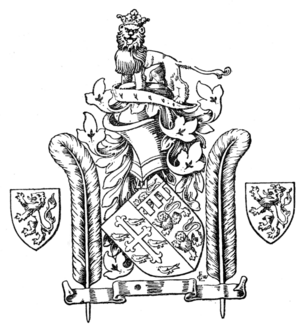
There's a famous legend about how the Black Prince got the badge. It says he took it from the helmet of the blind King John of Bohemia. This happened after the Battle of Crécy in 1346, where they fought against each other. The legend claims the prince took the king's helmet with its ostrich feather crest. He then used the feathers in his own symbols and adopted King John's motto, "Ich dien."
This story first appeared in writing in 1376, the year the Black Prince died. However, there's no real proof that King John used this motto or crest. He actually had a crest of vultures' wings. Still, King John was also the Count of Luxembourg, and they did use an ostrich feather as a symbol. So, the idea that the Black Prince adopted the badge to honor the brave king might still be true in a way.
Another theory connects the badge to Welsh archers. They were very important in the English victory at Crécy. Some say Edward adopted the symbol to show his pride in the Welsh soldiers. The Freemen of Llantrisant even claim their ancestors killed King John and captured his emblem. The German motto "Ich dien" ("I serve") sounds a lot like the Welsh phrase "Eich Dyn" ("Your Man"). This might have made the young Black Prince popular with the Welsh soldiers. But again, there's no historical proof for this idea.
The Lancaster Family and the Feathers
John of Gaunt, 1st Duke of Lancaster, who was the Black Prince's younger brother, also used ostrich feathers. He had a shield similar to the Black Prince's, but his feathers were white with black spots (called ermine). Single ostrich feathers were also used as supporters (figures holding up a shield) by John Beaufort, 1st Duke of Somerset.
King Henry IV, from the House of Lancaster, used a single ostrich feather badge. It had a scroll wrapped around it that said "Ma Sovereyne." His oldest son, King Henry V, sometimes used ostrich feathers as a secondary royal badge. Other royal princes also used similar feather badges.
The Tudor Family and the Feathers
The first Prince of Wales to use the badge in its modern form was Prince Arthur (1486–1502). He was the oldest son of Henry VII in the early 1500s. This modern form includes the three white feathers, the coronet, and the motto Ich dien.
Prince Edward, son of Henry VIII, also used the badge a lot. He later became Edward VI. Even though he was never officially made Prince of Wales, he used the symbol. Feathers continued to be used as smaller royal badges by others, including Elizabeth I, until the end of the 1500s.
The Stuart Family and Later
From the early 1600s, the badge became only linked to the Prince of Wales. Since at least 1901, it has been the main symbol on the heraldic achievement (full coat of arms) of the Prince of Wales. It is described as "A plume of three ostrich feathers argent enfiled by a coronet composed of fleurs-de-lys and crosses patée or alternately with motto Ich Dien."
Modern Uses of the Feathers
Military Use
Many British military groups use the Prince of Wales's feathers in their badges. For example, the feathers are on the cap badge of the Royal Welsh. This regiment was formed by combining three Welsh regiments. The badge of the Royal Navy's HMS Prince of Wales also includes the feathers.
Other British military units that use the feathers in their badges include:
- 2 Squadron Honourable Artillery Company (squadron badge)
- Cheshire Yeomanry
- Princess of Wales' Royal Regiment (cap badge)
- Royal Marines Band Service (cap badge)
- Royal Monmouthshire Royal Engineers (cap badge)
- Royal Wiltshire Yeomanry (cap badge)
- Royal Scots Dragoon Guards (Carabiniers and Greys) (arm badge)
The badge also appears on military unit badges in other Commonwealth of Nations countries. These countries have historical ties to the Prince of Wales. Some examples are:
- 4th/19th Prince of Wales's Light Horse (Australia)
- Princess of Wales' Own Regiment (Canada)
- Royal Regiment of Canada (Canada)
- Sri Lanka Light Infantry (Sri Lanka)
The Rashtriya Indian Military College, an Indian military academy, also uses the feather badge. It was once called the Prince of Wales Royal Indian Military College.
Past Military Use
Several older British Army units also used the Prince of Wales's feathers. They had these badges before they were disbanded or joined with larger units. Examples include the 2nd King Edward VII's Own Gurkha Rifles and the Staffordshire Regiment.
A single Prince of Wales's feather was also on the badge of HMS Norfolk. This ship was taken out of service in 2005.
On Coins
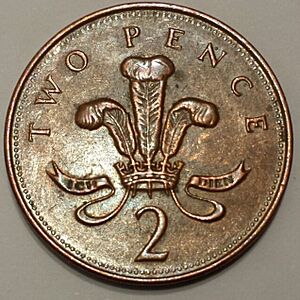
During the English Civil War, King Charles I minted many coins with the feathers. He did this because he couldn't use the Royal Mint in London. He moved a mint from Aberystwyth (which used Welsh silver) to other places. All these wartime mints were like branches of the Aberystwyth mint.
The badge was also on the back of British two pence coins made between 1971 and 2008. Many of these coins are still used today. The badge also appeared on silver coins from the 1600s and 1700s. This showed that the silver came from Wales.
In Sports
Surrey County Cricket Club was allowed to use the feathers for their badge in 1915. Their home ground, The Oval, is on land owned by the Duchy of Cornwall.
The feathers are on the badge of Wrexham Association Football Club.
The symbol of Lingfield Park Racecourse also includes the feathers. The Prince of Wales (who later became Edward VII) opened the racecourse in 1890.
Two shooting clubs at Oxford University, the Oxford University Pistol Club and the Oxford University Rifle Club, use the feathers as their logo.
Welsh Rugby

The feathers have traditionally been worn on the jerseys of players in the Welsh rugby union team. They were sewn onto jerseys even before a national team existed. Now, the Welsh Rugby Union (WRU) uses them as its official logo. In the 1990s, the WRU changed the design slightly to copyright it. The new logo is more modern and has the letters "WRU" instead of "Ich dien." The Prince of Wales' feathers are also part of the British and Irish Lions' badge.
Some people have asked the WRU to use a logo that feels "more Welsh." They see the feathers as a British symbol, linked to the British monarchy. In 2021, a group called YesCymru suggested other Welsh symbols like a leek, daffodil, or harp. Using a Welsh dragon has also been suggested.
Wales Rugby League (WRL) also used the three feathers for its logo from 1908 to 2005. After much discussion, the WRL officially changed its logo to a new Welsh Dragon design in 2022. The WRL chairman, Brian Juliff, said this step would help them create their own brand identity in Wales.
Other Uses
The Prince of Wales's feather is part of the Canadian royal standard for the Prince of Wales. The feathered badge is placed in the center of a blue circle, surrounded by golden maple leaves.
The Prince of Wales's feathers have been used in the coats of arms of several regions and towns. Norfolk County Council was allowed to use the badge by King Edward VII. This was because Sandringham House, one of the King's favorite homes, is in Norfolk. The badge was also used on the coat of arms of Penang until 1985. Penang is a state in Malaysia that the British settled in 1786.
A similar badge is used by the Prince's Trust. This is a charity started by Charles III when he was Prince of Wales. The Carlton Club in the UK also uses the feathered coronet badge as its symbol, but without the motto. A society in Malta called "The Prince of Wales Philharmonic Society" also uses the badge. Malta was a British colony for 200 years, and many clubs there are named after royal figures.
Many schools named after the Prince of Wales include his badge in their symbols. These include Prince Edward School in Zimbabwe, the Prince of Wales' College in Sri Lanka, and the Prince of Wales Secondary School in Canada. The badge is also on the foundation stone of Patna Medical College and Hospital in India.
Many pubs in the UK are named "The Prince of Wales's Feathers," "The Prince's Feathers," or "The Feathers." This is especially true in areas connected to royal estates.
See also



